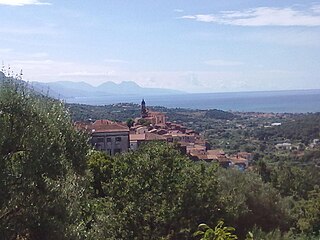
Agropoli is a town and comune located in the Cilento area of the province of Salerno, Campania, Italy. It is situated at the start of the Cilentan Coast, on the Tyrrhenian Sea.

Pisciotta is an Italian town and comune of the province of Salerno, in the region of Campania.

Casal Velino, also spelled Casalvelino, is a town and comune in the province of Salerno in the Campania region of south-western Italy.

Castellabate is a town and comune in the province of Salerno in the Campania region of south-western Italy. It is one of I Borghi più belli d'Italia.

Ogliastro Cilento is a town and comune in the province of Salerno in the Campania region of south-western Italy. As of 2011 its population was of 2,241.

Santa Marina is a town and comune in the province of Salerno in the Campania region of south-western Italy.

Torre Orsaia is a town and comune in the province of Salerno in the Campania region of south-western Italy.

Vibonati is a town and comune in the province of Salerno in the Campania region of south-western Italy.

Cilento is an Italian geographical region of Campania in the central and southern part of the province of Salerno and an important tourist area of southern Italy.

Palinuro is an Italian small town, the most populated civil parish (frazione) of Centola, Province of Salerno, in the Campania region. The name of the town is derived from Palinurus, the helmsman of Aeneas, as recorded in the fifth and sixth books of the Aeneid.

Policastro Bussentino is an Italian town and hamlet (frazione) of the municipality of Santa Marina in the province of Salerno, Campania region. It is a former bishopric, now titular see, and has a population of 1,625.

Cilento, Vallo di Diano and Alburni National Park is an Italian national park in the Province of Salerno, in Campania in southern Italy. It includes much of the Cilento, the Vallo di Diano and the Monti Alburni. It was founded in 1991 and was formerly known as the Parco Nazionale del Cilento e Vallo di Diano.

The Vallo di Diano is an Italian valley of the south-eastern side of Campania, in the province of Salerno.

Scario is an Italian village and hamlet (frazione), the largest of the municipality of San Giovanni a Piro in the province of Salerno, Campania region. In 2011, it had a population of 1,124.

The Cilento Coast is an Italian stretch of coastline in Cilento, on the southern side of the Province of Salerno. It is situated between the gulfs of Salerno and Policastro, extending from the municipalities of Capaccio-Paestum in the north-west, to Sapri in the south-east.

San Severino is an Italian village and hamlet (frazione) of the municipality of Centola in the Province of Salerno, Campania. As of 2011 its population was of 435.

Capitello is a southern Italian village and hamlet (frazione) of Ispani, a municipality in the province of Salerno, Campania. As of 2009 its population was of 626.

Villammare is a southern Italian village and the only hamlet (frazione) of Vibonati, a municipality in the province of Salerno, Campania. As of 2009 its population was of 1,024.

Licosa is a southern Italian village and hamlet of Castellabate, a municipality in the province of Salerno, Campania. As of 2009 its population was of 82.

The strada statale 18 "Tirrena Inferiore" is an Italian state road, connecting Campania and Calabria. It is among the longest and most important state highways in southern Italy, considering that it follows the Tyrrhenian coast, from Salerno to Reggio di Calabria.























